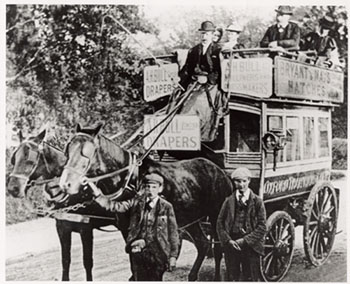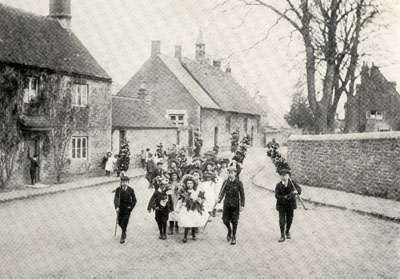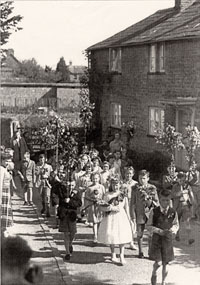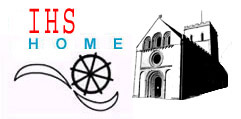History
Continued

|
|
Links with
Oxford
The firmest link
was through the church. The Archdeacon, at Christchurch cathedral, held
the right to appoint priests, and Christchurch was also a college of the
University. The Rectory and its estate were often let out to scholarly
gentlemen. Arthur Pits, Fellow of All Souls, lived there during the religious
upheavals of the sixteenth century; his widow harboured a Catholic priest
in the house, and two younger Pits fled abroad and became Jesuits. The
Archdeacon Barten Holyday, however, did live in the Rectory; he died there
in 1661, of the "epidemical fever that rageth now abroad".
It may be that many of the clergymen sent by the archdeacons to serve
at Iffley lived in Oxford and rode out to do their duty, when they could.
In the seventeenth century there are long gaps in the burial register:
no entries for much of the 1620s, nor 1640-52, nor 1660-77, nor 1687-92.
It does suggest that the priest in charge was not on the spot; not all
the dates coincide with times of upheaval.
At least two principal tenants of the manor were also university men,
David Lewis in the sixteenth century and Thomas Nowell in the eighteenth.
|
|

Horse Bus from Iffley Turn to
Oxford c1900
|
|
The Parliamentary
Gazetteer of 1843-44 says the parish of Iffley with Hockmore had 590 people
in 1801, and 1081 people in 1831. Oxford businessmen began to build houses
in Iffley from the 1790s onwards; villagers, working for them as servants
and perhaps becoming more aware of the city's opportunities, inspired
their children to look there for better and more varied employment. Occupations
given in the marriage registers after 1850 include: "railway worker
. . . bookbinder . . . college servant . . . livery-yard foreman . . .
engine driver . . .compositor . . . grocer's shopman . . ."
The school log from the 1870s records heavy truancy in summertime, when
boys went to work on the cricket fields off the Cowley Road. College rowing
eights race over a course that begins at Desborough Bridge, Iffley Lock;
at least one Iffley man was employed building skiffs and assisting at
the start of races in February and May.
At the turn of
the century it was possible to go into Oxford by horse-bus from Iffley
Turn. Shortly afterwards Iffley got mains water and sewer pipes, and was
finally incorporated into the city in 1928.
|
Back
To Top
Education, Charities
and Relief
The will of Alice Smith, 1679,
provided apprenticeships for poor children and gifts to the poor; Stephen
Field in the eighteenth century left money to buy bread. The Nowell
Trust educated poor children from 1805 and also made provision for the
aged. The parish overseers administered poor relief under Elizabethan
law until 1835, when Iffley joined a Union of 24 parishes, with a central
workhouse in Headington (see Links). There are few instances of Iffley
applicants going into the workhouse; most continued to receive relief
at home by application to the Union relieving officer.
|
|

Iffley classroom
|
|
There had been
dame schools and there would be small private schools, but the greatest
improvement was probably the opening of a National School in 1838, in
the building which is now the Church Hall; it functioned as a school until
1961, by which time a new primary school had been built on Rose Hill.
Back
To Top
|
Customs and Amusements
Eighteenth-century
memoirs mention Iffley Feast each September. The village was always
a favourite place of resort for Oxford people and had a number of public
houses of which the "house by the great elm tree" was a favourite.
Nineteenth-century memoirs describe village amusements celebrating May
Day.
|
|

Children's May-Day procession
through Iffley, 1906, by Henry Taunt

Iffley May-Day, 1967
|
Part of the
old township boundary was called Bear's Hedge after a visiting entertainer
with a dancing bear. The Foresters' Order (a friendly society) provided
its members with regalia and occasions to march about with a brass band
before sitting down to dinner. There were organised river trips to Nuneham
Courtenay, and river picnics. There were all the usual concerts and
"theatricals", designed to raise money - especially once the
fiddlers had been thrown out of the west gallery in the church and replaced
by an expensive organ needing constant attention.
Back
To Top
|
Farming and Small Trades
in Iffley
Before enclosure
in 1830, there were cottagers managing with small strips of land here
and there, which they used for vegetables or grazing. The swineherd
managed pigs on Hog Common south of the church. There was a farm attached
to the Donnington manor house, Court Place, and another belonging to
Lincoln College (its house now misleadingly called the Manor house).
The thatched house at the corner of Mill Lane was a farmhouse and there
was one in Meadow Lane. River meadows provided good pasture, and Iffley
sheep farmers also had grazing rights in Cowley and in Shotover Forest.


Bayeux Tapestry, c1077
|
|
Medieval farming
society involved people in varied odd jobs as part of the service they
owed for their own small holdings; a man might be obliged to use his cart
to carry his lord's goods, but he would not describe himself as a carter.
After the Black Death of 1349 this begins to change and the village acquired
wheelwright, weaver, carter, fuller ( who treated cloth) and maltster
- as well as the miller. There must have been a blacksmith. Malting (processing
barley for use in brewing ale) was important, and in wills of the 17th
and 18th centuries we have also a fisherman, a cidermaker and two victuallers
(who provided food and stores). (Parish registers do not reveal trades
until after 1830, when inclosure had tipped the balance from subsistence
smallholding to waged labour. There are numerous labourers and servants,
but also cordwainers (shoemakers), masons, carpenters, a seamstress and
a laundress. Shoemaking was an especially useful trade; it could be done
at home as a second occupation when there was no farm work, and its product
was always needed. The same was true of dressmaking, and taking in washing.
The masons and other building trades flourished with Victorian expansion,
as did shopkeepers.
|
Back
To Top
Modern Times
The change from
agricultural village to desirable suburb had become clear by the 1850s,
when there were 23 gentlemen's houses, most of them spread out between
the village and the main road. The Donnington Hospital was now aware
that letting land for substantial building was the best course; it therefore
allowed small cottages to fall into disrepair, and was criticised during
an inquiry in 1894-96. Poorer families moved out of the old village,
having found work and better accommodation in the growing east Oxford
suburbs. New building in Iffley was for middle-class tenants.
Donnington's developments were not intensive. The result was an area
of large houses with large gardens, pleasantly spaced and still grouped
among green fields with many open views of the river. Most infilling
has happened since 1960.
The old township fields filled up earlier. Oxford's motor and engineering
industries needed to house a growing labour force after 1920. Part of
Rose Hill was built up after 1930 and the rest from 1946, as a council
estate. Iffley village for the first time in its history had a close
neighbour, built on its own fields but at a time when its residents
were no longer field-workers - they had prosperous suburban households
with a suburban affection for peace and quiet. There have been problems,
of theft and vandalism. There have been gains, especially to the life
of the church. One Rose Hill resident served Iffley parish as a churchwarden
for 21 years.
Some of the old village families are represented on Rose Hill; with
rising property values there are few left in Iffley, and it was through
them that the village had its strong family links with Cowley. Links
with the university are still strong. Links with Littlemore, once thought
unbreakable, were weakened when Littlemore got its own parish church
in 1836, and severed by the Oxford Ring Road in 1966; the old church
way survives only as a footbridge.
|
| Old
Maps of Iffley |
|
1875
Ordnance Map of Iffley, Section 1, including Lock and Church, approx.
scale 1:2500, 71k,
1875 Ordnance Map of Iffley,
Section 2, including Iffley Turn, approx. scale 1:2500, 50k
1797 Map of South East Oxford
and Iffley, 61k and 110k
|
| Back
To Top |

